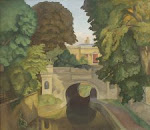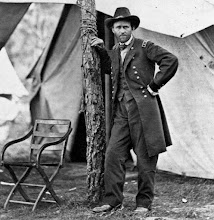Louis MacNeice has often been thought of as a Thirties (and Forties) poet and/or as one of the satellites circling Auden. However, in recent years it has been recognized that he stands on his own, and that the generational pigeon-holing is too simplistic. Still, a tendency remains to focus on the poems that he wrote during the Thirties and Forties -- poems such as "Wolves," "Snow," "The Sunlight on the Garden," and Autumn Journal. Although these poems (and many others from his earlier years) are indeed wonderful, I believe that MacNeice wrote a number of his finest poems later in his life.
After 1948 (when Holes in the Sky was published), MacNeice went through a dry spell that lasted nearly 10 years. He did publish Ten Burnt Offerings (1952) and Autumn Sequel (1954) during this time, but these lengthy poems were not of the same quality as that which had come before. However, things changed in 1957 -- the year in which MacNeice turned 50 and the year in which Visitations was published. In that volume, and in the two further books that were published prior to his too-early death in 1963 (Solstices in 1961 and The Burning Perch in 1963), MacNeice was again at his best.
House on a Cliff
Indoors the tang of a tiny oil lamp. Outdoors
The winking signal on the waste of sea.
Indoors the sound of the wind. Outdoors the wind.
Indoors the locked heart and the lost key.
Outdoors the chill, the void, the siren. Indoors
The strong man pained to find his red blood cools,
While the blind clock grows louder, faster. Outdoors
The silent moon, the garrulous tides she rules.
Indoors ancestral curse-cum-blessing. Outdoors
The empty bowl of heaven, the empty deep.
Indoors a purposeful man who talks at cross
Purposes, to himself, in a broken sleep.
Louis MacNeice, Visitations (1957).
Stanley Spencer, "Fire Alight" (1936)
Figure of Eight
In the top and front of a bus, eager to meet his fate,
He pressed with foot and mind to gather speed,
Then, when the lights were changing, jumped and hurried,
Though dead on time, to the meeting place agreed,
But there was no one there. He chose to wait.
No one came. He need not perhaps have worried.
Whereas today in the rear and gloom of a train,
Loath, loath to meet his fate, he cowers and prays
For some last-minute hitch, some unheard-of abdication,
But, winding up the black thread of his days,
The wheels roll on and make it all too plain
Who will be there to meet him at the station.
Louis MacNeice, Visitations (1957). The repetition in "Loath, loath to meet his fate" is very nice, I think.
Subscribe to:
Post Comments (Atom)




8 comments:
I've just returned from three weeks of working on a barge, must of the time in sub-zero temperatures (no “garrulous tides” but plenty of gushing locks!). It's good to be home but your first choice sums up perfectly how one can actually miss things like extreme cold.
Thank you for posting these two excellent poems.
Pomposa: it is always good to hear from you. Welcome back -- it sounds like you took an interesting excursion.
I'm glad that you like the MacNeice poems. Thank you for visiting again.
I very much liked the poems - plus the Stanley Spencer picture, which I hadn't seen before. I wonder if you've been to the chapel in Hampshire where his war murals are.
Thank you for stopping by again, zmkc.
I have not had a chance to visit Sandham Memorial Chapel yet -- it must be beautiful. It is on my list of things to do when I visit England -- as well as visiting the Stanley Spencer Gallery in Cookham.
Figure of eight is a superb poem. It demonstrates how a poem can encapsulate so much in so few words because the words and the form have been carefully chosen. Youth where everything seems possible and old age where the final destination looms. There is so much to say about this poem
william todd: thank you very much for visiting, and for your thoughts on "Figure of Eight." I agree with you: I think that it is one of MacNeice's finest poems.
Thanks again.
An observation on the hauntingly brilliant "Figure of Eight".
I may be stating the obvious here, but do you see that the rhyming scheme actually forms a figure of eight.
That is, draw three dots in a line, on a page. These represent the "a", "b" and "c" of the rhyming scheme. Now, draw a line, starting from a, through each dot, following the form of the rhyming scheme.
That is: " a b c b a c."
So starting from a, along to b, along to c, then loop back to b, back to, then loop back around toward c.
Hey presto. You now have a figure of eight. The symbol of infinity.
Man's a genius!
Anonymous: I had never thought of that before! But I can see how it could work that way. I think. I wouldn't put it past him to have planned it that way. Thank you very much for sharing that possibility -- it adds even more to a poem that, as you say, is indeed "hauntingly brilliant."
Post a Comment